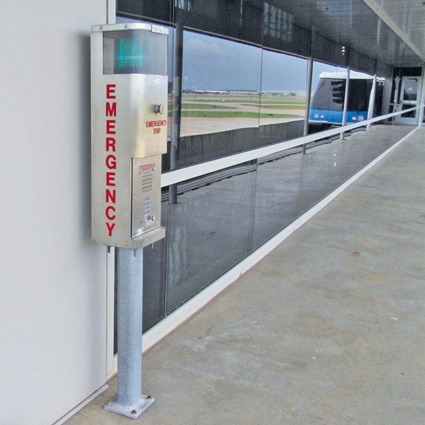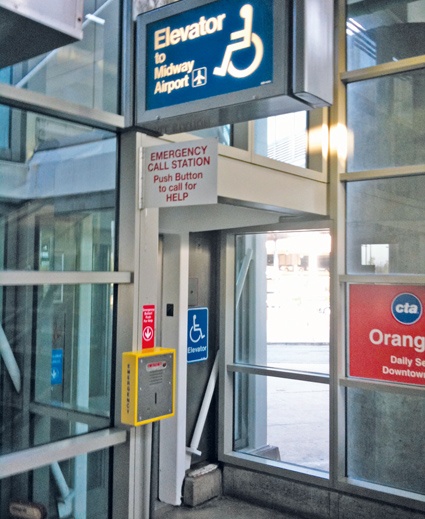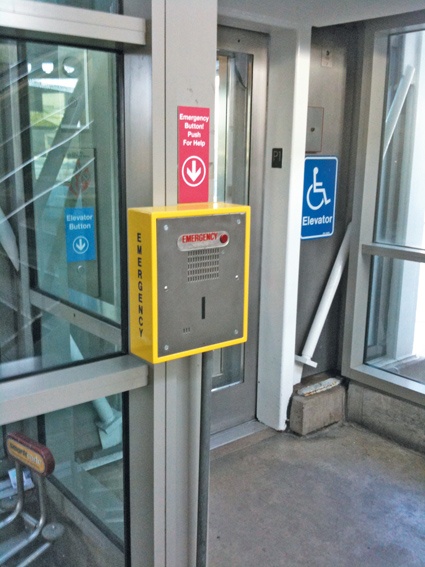Special Focus Alarm Systems: Security Self-help
If you have used any means of public transportation recently, you have almost certainly noticed that security measures have been continuously stepped up in recent years. Since al-Q...



If you have used any means of public transportation recently, you have almost certainly noticed that security measures have been continuously stepped up in recent years. Since al-Qaida leader Osama bin Laden's killing by U.S. Forces in May 2011, many Americans as well as those living in other major cities worldwide are still anxious of a retaliatory terrorist attack today. Security threats can also be countered by alert members of the public who report suspicious activity or items quickly by using dedicated communications systems.
Several major cities such as New York, Washington, D.C. and Los Angeles quickly deployed larger than usual numbers of policemen and security personnel at airports, subway and rail stations after the 9/11 attacks. The Transportation Security Administration (TSA) teamed up with transit agencies in all major cities across the U.S. in the light of Osama bin Laden's death. Just days after President Obama announced that U.S. Navy Seals killed bin Laden, TSA Administrator John Pistole, Federal Emergency Management Agency (FEMA), Director Craig Fugate of the NYC Police Department, Deputy Commissioner for Counter-terrorism Richard Daddario and Chicago Transit Authority (CTA) President Richard Rodriguez testified before the House Homeland Security Committee on Capitol Hill.
A number of U.S. lawmakers had expressed concern regarding the terrorist threat posed to the mass transit system in big cities across the United States. House Homeland Security Committee Chairman Peter King clearly stated, „Especially now in the wake of bin Laden‘s death, we have to assume that al-Qaida or its affiliates, al-Qaida in the Arabian peninsula, any of the others, any of the radicalized terrorists here at home, self-starters if you will, loan wolves or organized terrorist operations in this country will launch a domestic attack. And to me clearly, if we are talking about potential targets, no one is more of a potential target than our mass transit systems."
Recent history shows that attacks similar to the subway bombings in London, Madrid, Moscow and even normally peaceful Minsk are quite easy to orchestrate. The damage and casualties from those attacks were devastating, delivering a major blow to the economy and disrupting the fabric of life. So far, the United States has been fortunate enough to stop these attempts, thanks not only to the outstanding collaboration and efforts by the intelligence and task forces. The public are themselves also involved in security of transport systems by keeping watch for suspicious behavior, parcels or luggage left unattended or anything that strikes them as being out of the ordinary.
As soon as someone believes that they have seen something suspicious, there is no time to be lost in looking for a member of the transport staff to report it to. Highly visible communications points that set up a voice call to the control center belong on every platform, in every concourse and terminal. The long-established American designer and manufacturer Talk-A-Phone has specialized in such transport system communications devices. Their wide range includes surface-mounted and recessed one-button phones, emergency phone (refuge) stations and columns for various indoor and outdoor environments, either with or without a handset.
Money Well Spent
Most of the TSA's $8.1 billion 2011 fiscal budget, or about 71 percent, is spent on securing airlines. Only about 1 percent is currently spent on securing the surface transportation. Unlike airport security, which relies on high-tech scanning equipment and heavy video surveillance, transportation security is dependent on the eyes and ears of the general population. However, increasing security for transit systems as the nation is trying to reduce a nearly $14 trillion deficit is hardly an option. To make matters worse, the American Congress trimmed $50 million from a transportation security grant program this year. Homeland Security Chairman Rep. Peter King asked witnesses at the hearing on Capitol Hill for suggestions on how to protect the nation from a possible terrorist attack and how to cut the budget at the same time.
And while „there are no specific threats to mass or rail transit right now in the U.S.," according to John Pistole, we all must stay vigilant and recognize that prevention of an attack on American soil starts with each one of us. The idea of empowering the population of the United States with the task of securing their own homeland has both its supporters and skeptics.
Self-Initiatives
In July 2010 the Department of Homeland Security (DHS), at Secretary Janet Napolitano's direction, launched a national "If You See Something, Say Something" public awareness campaign. According to the DHS website, the initiative is designed to "raise public awareness of indicators of terrorism and violent crime, and to emphasize the importance of reporting suspicious activity to the proper state and local law enforcement authorities".
The campaign was launched in conjunction with the roll-out of the Nationwide Suspicious Activity Reporting Initiative (NSI). The NSI is an administration-wide effort to develop, evaluate, and implement common processes and policies for gathering, documenting, processing, analyzing, and sharing information about terrorism-related suspicious activities. Led by the Department of Justice, the NSI is implemented in partnership with state and local officials across the nation. Both programs underscore the concept that homeland security starts with hometown security, meaning every citizen of the nation plays a critical role in keeping us safe.
The operators of mass transit systems have had to consider which are the best methods, practices, and technologies for them to employ to enable citizens to be the watchful eyes and ears for mass transit safety. "If You See Something, Say Something" only works if there is a way to quickly and reliably inform the right security authorities of an actual or potential threat or problem so that the proper action can be taken before lives are lost. Reporting is made easy for potentially stressed passengers by keeping the operation of the voice terminals extremely simple. Just one push of a button on a terminal from Talk-A-Phone‘s ETP range will set up a call to the control center and provide hands-free communication to a crisis coordinator.
Local Transit
It is clear that although the TSA and FEMA support more security measures in all major transit centers in the U.S., local transit agencies will have to look for creative ways to secure transportation infrastructure if federal funding falls short. Public awareness campaigns combined with effective technology could help them achieve that goal.
The Chicago Transit Authority (CTA) is the second largest transit agency in the nation, providing services to 1.7 million riders daily on bus and rail networks. In March of 2011, the CTA was recognized by the DHS for achieving high scores in all categories of the security inspection program for transit. The CTA is among many U.S. transit agencies that has adopted the "If You See Something, Say Something" campaign. "This campaign was borrowed from the MTA in 2002 and encourages riders to report any suspicious activity that they observe," explained CTA President Richard Rodriguez. "In addition, CTA has participated and continues to participate in training for a number of scenarios using a range of programs." According to their website, "if you observe an unattended package, witness anything unusual or see someone acting suspiciously, alert a CTA employee or call 911 immediately."
Cell phone calls to 911 are a first thought; however, cell phones do not always work in the subway. Many transit agencies have chosen to deploy Talk-A-Phone emergency phones, which are easily seen and only require the push of a button to connect to the correct security personnel. Not only do they allow security personnel to instantly pinpoint the location of a caller, but they also provide the quickest way to contact security in case of an emergency. In addition, all CTA trains are equipped with a two-way intercom system, accessible to riders during an emergency.
Exit Signage
CTA, and other systems, have also installed emergency phones, signage, lighting and emergency walkways in the subway tunnels themselves so that, in the event passengers must leave the train between stations in an emergency, they can quickly and easily notify security of the emergency event which caused them to leave the stopped train between stations. Since these emergency phones automatically notify security of their location, it is easier to tell passengers what to do and to dispatch assistance to the right location.
"We have blue lights affixed throughout the subway in places where telephones are located. At all those telephones, passengers have the ability to push one button and they are able to talk directly to our control center," explains Myron Meredith in the public safety video produced by the CTA. "As they continue walking towards the emergency exit, there is a flashing blue light that will alert them to the location of that emergency exit, as well as the audio message that is playing that directs them to the emergency exit."
Personnel who are on duty at CTA's control center alert both the Chicago Fire Department and the Chicago Police Department to emergencies on the CTA's system. Fire and police personnel train alongside CTA staff to familiarize themselves with the subway tunnels and elevated structure. That way they can provide assistance to riders as quickly as possible when they respond to the scene. Myron confirms the importance of the control center, "As field employees, we are in direct contact with our control center, which has direct lines to the Police Department, the Fire Department and the OEMC (Office of Emergency Management and Communications)." The CTA continues to drill various emergency scenarios with both Chicago Fire and Police Departments.
Passenger Action
According to CTA President Rodriguez's testimony on Capitol Hill, the CTA's latest initiative to combat crime and deter terrorism is the installation of high-resolution digital security cameras. The network cameras allow the CTA, the Chicago Police Department and Chicago's Office of Emergency Management and Communication to gain a clear picture of an emergency situation and to respond accordingly. Sometimes it is not sufficient to simply notify the security personnel of an emergency, and while security cameras supply critical information to the security personnel, they do not have a chance to act on an event. Immediate action taken by mass transit riders can save lives, if the platform is equipped with the right tools.
Back in 2009, a story of a woman whose toddler was flung off a CTA platform took the headlines. A Red Line train started from the Morse station with a stroller caught in its doors, dragging it down the platform and flinging the 22 month old toddler alongside the tracks. The girl did not hit the third rail and was far enough away from the tracks of a departing train. While this story has a happy ending, a person falling on the tracks is unfortunately not a rare occurrence. Many local transit authorities have since taken preventative measures.
The Phoenix (Arizona) Light Rail and the Sacramento (California) Transportation Authority went a step further with public safety efforts by installing a special emergency communications device equipped with a kill switch on platforms. The unit empowers everyday users of public transportation with the ability to cut the power to the tracks by pushing an emergency button - anyone can hit the emergency button and immediately cut the power to the tracks. Units include Talk-A-Phone‘s IP emergency phones, highly visible blue lights, emergency lettering and instructions, raising awareness of public transportation riders. In some locations the units are wall mounted and in others mounted on their own integrated stainless steel post.
Securing the transition points from one transportation medium to another is also a must. Emergency phones are strategically placed at such locations to allow the public to report any suspicious activity that might be taking place. This technology has been employed at various transit authorities in the United States, including the CTA's Orange Line connection to the Chicago's Midway Airport. Parking garages and outdoor parking lots adjacent to airports also require a duly diligent approach when it comes to security. Proper access point planning, emergency phones and surveillance all play an important role in terror plot prevention. The CTA's Park and Ride lots use a combination of emergency phone towers and Pan-Tilt-Zoom surveillance cameras to quickly zero in on any emergency situation.
Eyes Open
Layers upon layers of security play a critical role in creating a safe and secure environment. However, even the best of technologies fail to detect the malicious intent of a lone individual, be it a radicalized homegrown terrorist or a member of a larger terrorist organization. We must all learn to critically observe our environment and then report anything out of the ordinary. We have the tools at our disposal; now it's a matter of looking after each other. Extreme caution must be exercised to not fall for ‚false economies‘ by reducing funds to transportation security. Congressman King said the human and economic costs of a successful terrorist attack would far outweigh any money saved on security for mass transit. Staying at least one step ahead of our enemies is the name of the game.
Business Partner
Talk- A- Phone7530 N.Natchez Ave.
Niles, IL 60714
Germany
most read

Integrated and Futureproof: Traka’s Next Chapter
Interview with Stefni Oliver on Traka’s Vision for the Future

Security management, building security & perimeter protection: the winners of category E at the GIT SECURITY AWARD 2026
GIT SECURITY AWARD 2026: Security management, building security & perimeter protection - an overview of the most innovative solutions


Machine & plant safety: The winners of category A at the GIT SECURITY AWARD 2026
GIT SECURITY AWARD 2026: Machine & plant safety - an overview of the most innovative solutions

Video security & video management: the winners of category C at the GIT SECURITY AWARD 2026
GIT SECURITY AWARD 2026: Video Security & Video Management - an overview of the most innovative solutions







